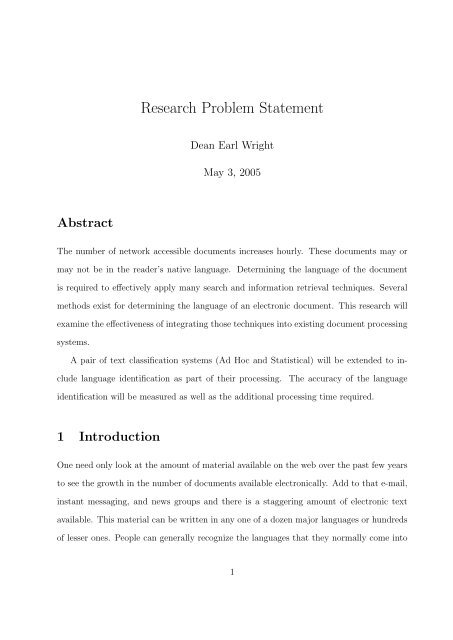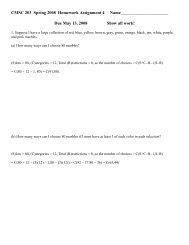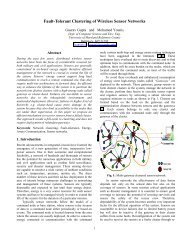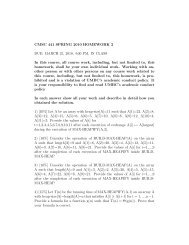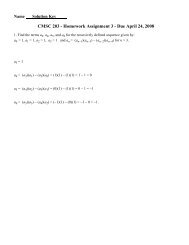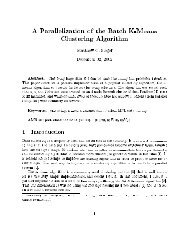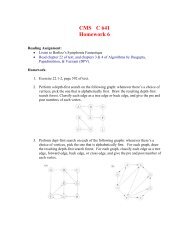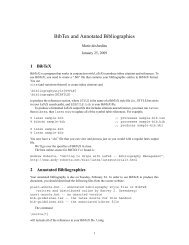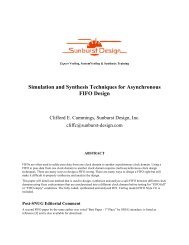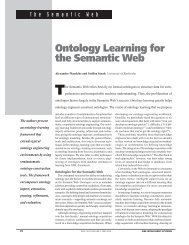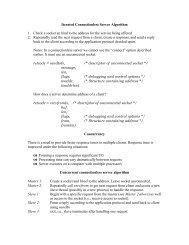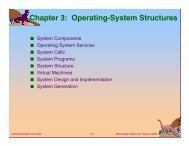Research Problem Statement
Research Problem Statement
Research Problem Statement
You also want an ePaper? Increase the reach of your titles
YUMPU automatically turns print PDFs into web optimized ePapers that Google loves.
<strong>Research</strong> <strong>Problem</strong> <strong>Statement</strong>Dean Earl WrightMay 3, 2005AbstractThe number of network accessible documents increases hourly. These documents may ormay not be in the reader’s native language. Determining the language of the documentis required to effectively apply many search and information retrieval techniques. Severalmethods exist for determining the language of an electronic document. This research willexamine the effectiveness of integrating those techniques into existing document processingsystems.A pair of text classification systems (Ad Hoc and Statistical) will be extended to includelanguage identification as part of their processing.The accuracy of the languageidentification will be measured as well as the additional processing time required.1 IntroductionOne need only look at the amount of material available on the web over the past few yearsto see the growth in the number of documents available electronically. Add to that e-mail,instant messaging, and news groups and there is a staggering amount of electronic textavailable. This material can be written in any one of a dozen major languages or hundredsof lesser ones. People can generally recognize the languages that they normally come into1
contact with but, with the click of the mouse, you can retrieve almost anything from almostanywhere in almost any language.Determining the language of an electronic document has been an area of active researchfor many years. Numerous methods have been proposed based on linguistic, statistical,and vector space analysis of the unknown document. All of the methods work. That is,they do identify the language of the electronic text fairly accurately. The level of accuracyvaries but is almost always above 90% and generally above 98% once the input text sizeis sufficient. What differentiates the methods is their computational requirements, theirability to provide an estimate of the accuracy of their identification, the ability to handlenoise in the input (misspelled words or the inclusion of passages from multiple languages,the amount of training text required, and the ability to scale in order to handle manylanguages.Language determination is often the first step in a text processing system that mayinvolve machine translation, semantic understanding, categorization, routing or storage forinformation retrieval. Knowing the language of the text allows the correct dictionaries,sentence parsers, profiles, distribution lists, and stop-word list to be used.Incorrectlyidentifying the language would result in garbled translations, faulty or no informationanalysis, and poor precision and recall in searching.While existing language identification methods can produce reasonable results, theyoften do so at a large computational cost (in terms of both space and time). Many methodsrequire large lists of words and/or n-grams with associated frequency counts for eachlanguage. Others require matrices whose size is dependent on the number of unique wordsand the number of documents in the reference language set. Calculations on large lists andmatrices make these methods expensive to use.To reduce the expense of language determination, the language determination methodshould be integrated into the larger text processing system and make use of the data structuresand calculations performed. When integrated at this level, language determination2
can be done without causing a negative impact on the system.To demonstrate the integration of the language determination function within a textprocessing system, I propose to add language determination to a text categorization systemso that the system is capable of identifying several (at least a dozen) European Unionlanguages (encoded using Latin-1) with at least 98% accuracy and not require more than5% additional processing as measured by CPU usage.2 BackgroundImagine that your job is to sort incoming mail at an embassy or consulate. The incomingmail is to be sorted into four piles:visa requests The most numerous type containing requests for tourist, student, and workvisas.citizen matters Requests for replacement passports and other assistance to the travelingcitizen.cultural exchange Requests and offers for the sharing of music, art, and stage productions.other Any items not covered above including military and intelligence matters.Most of the mail is addressed to the ambassador so the address is of little help. Each lettermust be opened and the contents (or at least a portion of them) read to determine theproper pile.This kind of problem is one of Text Classification where you must choose the mostlikely category for each document. While the category is usually a subject area, categoriescan also be anything that divides the documents into subsets.Reading level, author’ssex, suitability for employment can all be used as categories. Identifying the language of3
a document is also a Text Classification problem where the category you are trying todetermine is the document’s language.2.1 Text Classification MethodsMany different techniques can be used for Text Classification. They can be divided intothree categories representing both a general chronological order and that of increasingcomplexity.2.1.1 Ad Hoc Text Classification MethodsIf you classify the embassy’s mail by looking for a key word such as visa to select mail for thevisa request category, you are using an Ad Hoc classification method. Ad Hoc classificationsystems require knowledge of what should and should not be in each category. This isusually obtained from the people currently performing the classification when automatingan existing manual process. The expert knowledge is then embodied within the system asrules or searches. While the general techniques of ad hoc classification (e.g. searching forkey words or phrases) can be used in different systems, each system will require an expertto craft the specific rules.2.1.2 Statistical Text Classification MethodsBy examining a number of documents that belong to each category, a statistical model ofthe perfect document for that category can be made. Any one of several of many differentitems can be used for the statistical measures. Often it is short groups of characters, calledn-grams. When faced with the task of putting a document into a category, the statisticalmeasures of the new document are taken and then compared to the statistics of each ofthe categories. The category whose statistics are the closest match to the new documentis the category selected.4
2.1.3 Latent Semantic Analysis for Text ClassificationOne statistic that can be used is the number of times each word appears in the document.This is done for a number of documents. A processing and memory intensive procedure isthen performed to obtain the Single Value Decomposition of the words by document matrixmapping each document in an n-dimensional space. This information is used to clusterthe documents into groups. Each cluster represents a different category. To categorize anew document, its words are processed to map it into the n-dimensional space and thendetermine the cluster to which it is closest.2.2 Language Identification MethodsAs mentioned above, Language Identification, is a form of text classification. Thus, any ofthe techniques of text classification can be applied to language identification.2.2.1 Ad Hoc Language Identification MethodsAd Hoc or Linguistic methods use some aspect of the language to identify it.Theseapproaches are usually dictionary-based with a set of words from each language. As largedictionaries take longer to process, the dictionaries are usually lists of the short, commonwords in the language such as pronouns, articles, and prepositions.(In text retrievalsystems these lists would be the ”stop” words lists used to prevent indexing on words withlittle semantic meaning.) When trying to identify the language of an unknown document,each list is consulted and the document is declared to be of the language with the mostmatching words.Norman Ingle[4] created a method using only one and two letter words. While designedfor use by librarians it is easily automated. One starts by assuming that the unknowndocument could be of any language. Then the one and two letter words are examined tosee which languages use that word. Languages that don’t use the word are eliminated. Theprocess continues until all the one and two letters words have been examined or until all5
ut a single language is identified.2.2.2 Statistical Language Identification MethodsAs with statistical test categorization, sample documents from each language are subjectedto a statistical analysis based on some characteristic of the text.This is often n-gramcharacter analysis or counts of short words. Gregory Grefenstette[3] compared the use ofsmall words and tri-grams. Tri-grams worked better on short sentences but as the lengthof the text grew larger, they both performed about the same.To determine the language of a document, the same statistical procedure is done tothe new document and the document’s statistics are compared to those derived from thelanguage training documents to determine the closest match.2.2.3 Vector Language Identification MethodsLaura Mather[5] provided a vector space model using single value decomposition. All ofthe words in the unknown document are added as another column of an m by n where mis the number of unique words and n is the number of documents. An iterative algorithmpartitions the matrix so that the unknown document will be clustered with other documentsof the same language. The matrix processing requirements are alleviated somewhat butusing the power method instead of full SVD as only the parts of SVD results are used.Experiments using subsets of fifteen languages achieved only 92% correct identification.There was the common problem of the closeness of Portuguese, Spanish and Italian, butproblems were also caused by classifying the tab character as a word in several languagesand having a small number of samples of some languages.6
3 Technical Approach3.1 Selection of Compatible Text Classification and LanguageIdentification MethodsIn order to integrate a language identification capability into a text classifying systemwithout a significant increase in processing, the two methods need to share the same datastructures and do as much of the processing as possible in common. The obvious startingplace is to to select methods that are both either ad hoc, statistical, or vector based.I propose to investigate two such matched pairings. Julian Yochum[6] describes a fasttext searching technique used to implement an ad hoc text classification. The fast textsearching will be used with stop word lists from various languages to do ad hoc languageidentification. The same fast search technique was used to implement a statistical textclassification method[7] which which can be paired with a statistical language identificationtechnique.3.2 Ad Hoc Text Classification with Language IdentificationThe fast text search method will be implemented in Python (or Java - the final choicehas not been made). This will include programs to determine trigraph frequencies froma training set of documents, optimize searches based on trigram frequencies, and classifya document by executing the optimized searches. Additionally, classification searches andexecution scripts will be created.The document classification program will be extended to run additional searches basedon stop word lists for languages. A program to create classification searches from stop wordlists will be created as well as additional execution scripts.7
3.3 Statistical Text Classification with Language IdentificationGiven the fast text searching program generated for the testing of the ad hoc methods,classification using statistical measures will require little additional coding. Again, a textclassification program will be created and then augmented to include language identification.A program will be developed to create classification searches from the trigram frequenciesof the training documents. This program will be run against category trainingdocuments to obtain the category matching statistics and against the language trainingdocuments to obtain the language matching statistics. Execution scripts will be created toautomate the running of the programs.4 Methodology4.1 Obtaining Test DocumentsDocuments from many languages will be needed to test the combined text classificationand language identification system. Many documents are available on the internet as wellas from other sources (e.g. USENET).4.1.1 CDROMA couple of papers reported using the European Corpus Initiative Multilingual Corpus 1CDROM from the Association for Computing Linguistics. Using this corpus of documentshas the advantages of having had other language identification researchers already examineit to find any weaknesses and it will provide a basis of comparison with their results.4.1.2 Criteria for Usable LanguagesThe ECIMC1 CDROM contains samples of 23 languages but not all can be used. Severalof the languages have only only one or two documents and some are not in the Latin-18
encoding. This leaves about 15 languages which will be enough to validate the processing.4.1.3 Extraction and Verification of DocumentsFor each usable language on the ECIMC1 CDROM, the documents will be examined todetermine suitability for the testing (e.g. Dictionaries and multi-language parallel textswill be discarded). The remaining documents will be broken into fifty-line (approximatelyone page) files. These files will be processed using Ingle’s method to validate the targetlanguage.4.1.4 Training and Experimental DocumentsThe statistical text classification and language identification methods require training documents.One third of the files of each language (randomly chosen) will be reserved as thetraining set for that language. The remaining documents will be randomly split into twotest sets.All three sets of document files (the training set and the two test sets) will be processedto obtain the trigram frequency counts. A Friedman two-way analysis of variance by rankswill be done to ensure that any differences in the trigram frequencies between the threesets is due only to randomness. Except for this verification, the trigram frequency numbersfrom the two test sets will not be used.4.2 Creation of Test SoftwareAs mentioned above, several pieces of software will be created to test language identificationwithin a text classification system. The programs will be created in an object-orientedmanner to facilitate reuse among the components and to keep the actual coding to aminimum.9
4.2.1 Trigraph Extraction and Frequency CountingThe fast text search algorithm uses only a reduced character set of the 26 uppercase letters,the numbers, and a blank. This gives a 37 character set to which 3 additional (unused)characters are added giving 40 characters total. When counting trigrams from a trainingset, the 40x40x40 matrix is initialized to all zeroes. Then, for all document in the trainingset, the characters in a document are mapped to the reduced character set. As the trigramsare extracted from the reduced character set document, the appropriate entry in the matrixis incremented. After processing all documents in the training set, the counts in the matrixare scaled and written to a file.A table with the mapping of the characters of the Latin-1 set to the reduced characterset will be created. This mapping will be encapsulated in a reusable object. The operationson the trigram matrix will also be done in a reusable object. Using these objects, a programto create the frequency file will be created.4.2.2 Search OptimizationThe Text Classification routine needs to have the searches ordered by the least frequenttrigram in order to process efficiently. A program will be created to read in a file containinga search (search terms connected with ANDs and Ors) and order the internal search testingorder based on a trigram frequency table. The optimized search is a table of trigrams tocheck and action to be taken based on success or failure. The table is output to a file forinput into the text classification routine.4.2.3 Text Classification RoutineThe text classification routine takes a number of optimized searches and unknown documentsand, depending on the results of the search, assigns one or more categories to eachdocument. The classifier loads all of the searches and then processes each document inturn. For each document, the trigram searching tables are built. Then each search is ex-10
ecuted against the tables and is evaluated as true or false. The name of each search thatevaluated to true is associated with the document as its category.The character set mapping and trigram extraction objects from the trigram frequencycounters are reused. The search evaluator uses the optimized search action tables and thedocument’s trigram searching tables to evaluate each search. The results for each documentare written to a file showing which searches succeeded. The same text classifier routine isused for both ad hoc and statistical categorization. The difference is how the searches areconstructed.4.2.4 Language Identification RoutineThis is the same as the text classification routine, but two sets of optimized searches areused: one for text classification and a second set for language identification. The sametext classifier routine is used for both ad hoc and statistical language identification. Thedifference is, again, how the searches are constructed.4.2.5 Ad Hoc Text Classification SearchesIn order to establish the processing baseline for the text classification task, the text classifierwill need a set of text classification searches. These searches will divide the English languagedocuments from the ECIMC1 CDROM into a number of categories. The exact categorieswill be determined after a review of the documents. Several dozen categories will be selectedand a search created for each category.4.2.6 Ad Hoc Language Identification SearchesAd hoc language identification will be done by matching a document against a list ofthe common language words for each language. Stop word lists are available for severallanguages. A program will be created to take a list of words (one per line) and create asearch from all the words.11
4.2.7 Statistical Text Classification SearchesIn order to do statistical text classification, a set of searches will be programatically generatedfrom the trigram frequencies of the documents in each category. A program will bedeveloped that takes a trigram frequency table and produces searches for the top n searcheswhere n can be set as needed.4.2.8 Statistical Language Identification SearchesThe process for creating these searches is the same as for creating the statistical text classificationsearches. The same program will be used. The only differences is that the trigramfrequencies of the language training sets will be used as input to the search generator.4.2.9 Test ScriptsAll of the work to set up to run a test, the running of the test, and the evaluation of theresults will be done under the control of a test script. This will allow rerunning of the testsas needed and prevent that most unstable of elements (the researcher) from making simplemistakes that invalidate the test results.4.3 Experiments4.3.1 Ad HocThe training set documents are processed to obtain the trigram frequencies. These trigramfrequencies will be used to optimize the text categorization and language identificationsearches.Test sets one and two are will be processed by the Ad Hoc Text Classification Systemwith the running time and the document categories recorded. Test sets one and two willthen be processed again using the Ad Hoc Text Classification System augmented with thead hoc language identification searches with the running time, the document categories, and12
the identified language recorded. The tests will be repeated ten times to account for anyvariability in processing times for a total of forty experimental runs for ad hoc processing.4.3.2 StatisticalThe training set documents, divided into groups, will be processed to obtain the trigramfrequencies. These trigram frequencies will be used to create the category and languageidentification searches. The searches will be optimized using the overall trigram frequenciesobtained in the ad hoc processingTest sets one and two will be processed by the Text Classification using the statisticallygenerated text classification profiles with the running time and the document categoriesrecorded. Test sets one and two will then be processed again using both the text classificationand language identification searches with the running time, the document categories,and the identified language recorded.The tests will be repeated ten times to accountfor any variability in processing times for a total of forty experimental runs for statisticalprocessing.4.4 Analysis of ExperimentsA grand total of eighty experiments will be run: forty each for ad hoc and statisticalapproaches.For all of the experiments, the processing time and the text classificationresults were recorded. Half of the experiments also have the language identified. All of thisdata will be examined to evaluate effectiveness of including language identification withtext classification.4.4.1 Analysis of Processing TimesThe processing times for the set one and set two test data ought to be the same. For each ofthe four sets of data a paired t-test will be used to validate that the only difference in thesetimes is due to random factors. Next, the times between runs with and without language13
identification will be compared to see how much additional processing was required forlanguage identification. A t-test will be used to determine if the additional processing timeis significant.4.4.2 Analysis of Text ClassificationWhile the the robustness of the text classification technique was not a variable in this experiment,it is necessary to ensure that the text classification results were not altered by theaddition of the language identification process. Any discrepancy between the text classificationwith and without the language identification component represents an unacceptablecondition.4.4.3 Analysis of Language IdentificationThe language results would be examined to see which documents were misidentified. Eachof these documents will be examined to see if they are anomalies which should be discardedor genuine misidentifications. Anomalies may be removed from the test sets andthe experiments rerun.For both ad hoc and statistical language identification methods, an overall percentcorrect, and percent correct by language will be calculated. For both methods, a confusionmatrix will be produced, showing with which languages the misidentified documents wereconfused.5 ResultsNothing yet, but watch this space.Paper number one would be an evaluation of thelanguage files on the ECIMC1 CDROM using Ingle’s technique.14
6 Related WorkMost of the papers on text classification or language identification talk about one or theother but not both. Of those that discuss both, they are described as separate processes.Cavnar and Trenkle[1] discuss using n-grams for classifying one group of USENET documentsand then language identification on a different set of documents. Marc Damashek[2]clustered n-grams for languages and wire service articles but with different scoring algorithms.7 Future WorkLatent Semantic Analysis provides a powerful concept based search mechanism but atan expensive processing price. How much of that processing can be reused for languageidentification?8 ConclusionsMultiple methods are available for performing Language Identification.Most of thesemethods share algorithms and data structures with Text Classification methods. Carefullypairing the techniques will allow obtaining language identification at the same time astext classification with little additional processing. Systems that process large numbers ofdocuments or have strict processing time requirements will benefit most by combining thetwo activities.15
References[1] Willian B. Cavnar and John M. Trenkle. N-gram-based text categorization. In Proceedingsof the Third Annual Symposium on Document Analysis and Information Retrieval,pages 161–169, 1994.[2] Marc Damashek. Gauging similarity with n-grams: Language-independent categorizationof text. Science, 267(5199):843–848, 1995.[3] Gregory Grefenstette. Comparing two language identification schemes. In 3rd InternationalConference on Statistical Analysis of Textual Data, pages 130–137, 1995.[4] Normal C. Ingle. A language identification table. The Incorporated Linguist, 15(4):98–101, 1976.[5] Laura A. Mather. A linear algebra approach to language identification. In PODDP’98: Proceedings of the 4th International Workshop on Principles of Digital DocumentProcessing, pages 92–103. Springer-Verlag, 1998.[6] Julian A. Yochum. A high-speed text scanning algorithm utilizing least frequent trigraphs.In IEEE International Symposium On New Directions In Computing, 1985.[7] Julian A. Yochum. <strong>Research</strong> in automatic profile creation and relevance ranking withLMDS. In Overview of the Third Text Retrieval Conference (TREC-3). NIST SpecialPublication 500-225, 1995.16


